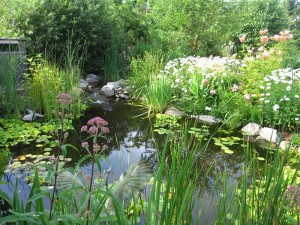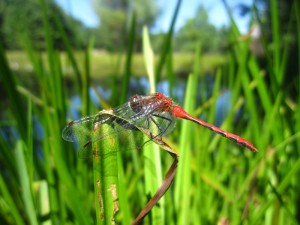Ponds
Last week we talked about tadpoles and frogs: what they eat, where they live, and what kinds of features you can add to your garden to make them happy.
This week we’ll delve into the world of garden ponds. If you’re looking to make the biggest splash (pun intended) where increasing biodiversity is concerned, look no further than a pond. One square meter of space is all you need. Let’s talk about what else you need.
The Space
Like I said earlier, one square meter is plenty to get those biodiversity juices flowing. It provides enough water, surface area, and perimeter (i.e. habitat) to support the lives of numerous creatures. Think frogs, dragonflies, lily pads and their stunning flowers, newts and salamanders, and the list goes on.
Each of the areas I listed above provide living, breeding, and eating quarters for the species you will attract. Some of them will use one area exclusively and others will take advantage of the range of options.
When deciding where to locate your pond, ensure it gets some shade, especially if it’s a smaller pond. Sun promotes algae which can, in turn, upset the balance in the system.
The Components
Most backyard ponds require some sort of liner designed to keep the water where you put it. If you didn’t need a liner, there’s a good chance there would already be a natural pond in the area. If you’re making this a DIY weekend project, check with your local stores as pond supplies are popping up everywhere.
You will also need a pump to keep water moving and prevent stagnation. The size of the pump you’ll need will be specific to the volume of water it needs to move around. I would recommend consulting with an expert on this. I can tell you from experience that improper water circulation can lead to some pretty unattractive pond water.
The plant life that you put in and around your pond will depend on two things: what you like and what will survive. I recommend using native plants wherever you can, especially in and around a pond. Spotted Joe-pye weed, marsh marigold, blue flag iris, cardinal flower will do well on the edges. In the water you want to include different levels of plants: surface and submerged. On the surface, go for the visually appealing: water lotus and white and yellow water lilies. For your submerged plants, try mermaidweed and coontail (hornwort).
And while building a pond may not be exactly a weekend project for everyone, it is well worth the time it takes. Check out the Canadian Wildlife Federation’s pond guide for some additional tips and tricks and I recommend you either hire a professional or do some serious research for what will work best in your area.
You will not be disappointed with the wildlife that comes snooping around once you have a pond in place.






